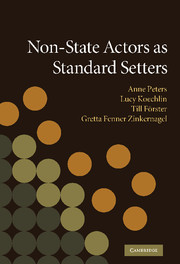Book contents
- Frontmatter
- Contents
- List of figures
- List of tables
- List of contributors
- Acknowledgements
- List of abbreviations
- Preface
- 1 Non-state actors as standard setters: framing the issue in an interdisciplinary fashion
- PART I New actors and processes in contemporary standard setting
- 2 Local and regional non-state actors on the margins of public policy in Africa
- 3 Conceptualising the use of public–private partnerships as a regulatory arrangement in critical information infrastructure protection
- 4 Standard setting at the cutting edge: an evidence-based typology for multi-stakeholder initiatives
- 5 New standards for and by private military companies?
- 6 Governance matters VII: aggregate and individual governance indicators 1996–2007
- 7 Contending with illicit power structures: a typology
- PART II The legitimacy and accountability of actors and standards
- PART III The authority and effectiveness of actors and standards
- Index
- References
7 - Contending with illicit power structures: a typology
from PART I - New actors and processes in contemporary standard setting
Published online by Cambridge University Press: 06 January 2010
- Frontmatter
- Contents
- List of figures
- List of tables
- List of contributors
- Acknowledgements
- List of abbreviations
- Preface
- 1 Non-state actors as standard setters: framing the issue in an interdisciplinary fashion
- PART I New actors and processes in contemporary standard setting
- 2 Local and regional non-state actors on the margins of public policy in Africa
- 3 Conceptualising the use of public–private partnerships as a regulatory arrangement in critical information infrastructure protection
- 4 Standard setting at the cutting edge: an evidence-based typology for multi-stakeholder initiatives
- 5 New standards for and by private military companies?
- 6 Governance matters VII: aggregate and individual governance indicators 1996–2007
- 7 Contending with illicit power structures: a typology
- PART II The legitimacy and accountability of actors and standards
- PART III The authority and effectiveness of actors and standards
- Index
- References
Summary
Framing the problem
Of the nearly $2 trillion of Official Development Assistance (ODA) given by the major industrialised states since 1950, the vast majority of those funds and associated efforts to improve the lot of people in developing countries have been directed at the formal governmental institutions of the developing states. Historically, the World Bank and regional development banks, as well as many bilateral development agencies, being governmental or inter-governmental organisations themselves, have focused on national budget support, debt relief or capacity-building within state institutions. Over the past two decades, some donors have recognised the central role of the private sector, democracy and good governance in successful development and increased their emphasis on market development, the rule of law, elections, legislatures, local governments and local civil society organisations. These approaches were predicated on the thesis that developmental and governance failures result from deficits in the formal state institutions, or the under-development of markets and traditional civil society.
This chapter seeks to further a complementary thesis: while institutional and civil society deficits certainly contribute to state failure and the lack of development, there is an additional dimension populated by a rogue's gallery of organisations (referred to in this chapter as ‘illicit power structures’). These structures inhabit the dark space of the political economy and operate often under the analytic radar. They subvert and impede democratic consolidation and successful development and they obstruct viable peace in the wake of internal conflict.
- Type
- Chapter
- Information
- Non-State Actors as Standard Setters , pp. 189 - 212Publisher: Cambridge University PressPrint publication year: 2009
References
- 2
- Cited by



